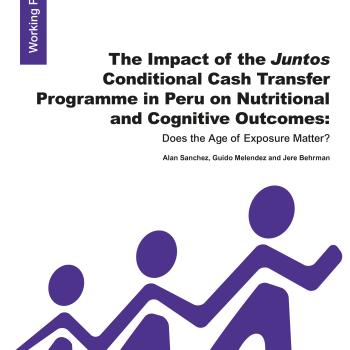Publication Information

Juntos is a large-scale conditional cash transfer (CCT) programme implemented in Peru since 2005. This programme transfers the equivalent of about US$30 monthly (around 10 per cent of monthly consumption) to poor families located, mainly, in the rural highlands, on condition that all children under the age of 5 are subject to growth monitoring controls, all children and adolescents attend school, and all pregnant women attend regular check-ups, among other aspects (conditions have evolved over time). We use data from the Young Lives study in Peru to analyse the impact of this programme on nutritional and cognitive outcomes between the ages of 7 and 9, paying special attention to the role played by the age of first exposure.
The main findings are as follows:
Exposure to Juntos leads to a reduction in severe stunting and an improvement in height-for-age, but only for those exposed during the first three years of life. This suggests that the age of exposure to the programme matters. While no measurable impact on stunting is detected, a reduction of severe stunting is observed. No impact on cognitive development (as measured by a vocabulary-development test) is detected, either for those children exposed during the first three years of life or for those exposed later.Peru has made substantial progress in reducing child stunting. The Peruvian CCT is likely to have contributed to this trend, but it is interesting to observe that to a large extent it helped mainly those children who were worse off in nutritional terms. Our results also show that the age of the child when first exposed to the programme is crucial. While early exposure to a CCT might lead to cognitive gains, due to the combined effects of attending school and being better nourished, we are not able to detect such effects in the Peruvian case. Future innovations in the Juntos programme should take account of these results when ways of maximising its potential are considered.

Juntos is a large-scale conditional cash transfer (CCT) programme implemented in Peru since 2005. This programme transfers the equivalent of about US$30 monthly (around 10 per cent of monthly consumption) to poor families located, mainly, in the rural highlands, on condition that all children under the age of 5 are subject to growth monitoring controls, all children and adolescents attend school, and all pregnant women attend regular check-ups, among other aspects (conditions have evolved over time). We use data from the Young Lives study in Peru to analyse the impact of this programme on nutritional and cognitive outcomes between the ages of 7 and 9, paying special attention to the role played by the age of first exposure.
The main findings are as follows:
Exposure to Juntos leads to a reduction in severe stunting and an improvement in height-for-age, but only for those exposed during the first three years of life. This suggests that the age of exposure to the programme matters. While no measurable impact on stunting is detected, a reduction of severe stunting is observed. No impact on cognitive development (as measured by a vocabulary-development test) is detected, either for those children exposed during the first three years of life or for those exposed later.Peru has made substantial progress in reducing child stunting. The Peruvian CCT is likely to have contributed to this trend, but it is interesting to observe that to a large extent it helped mainly those children who were worse off in nutritional terms. Our results also show that the age of the child when first exposed to the programme is crucial. While early exposure to a CCT might lead to cognitive gains, due to the combined effects of attending school and being better nourished, we are not able to detect such effects in the Peruvian case. Future innovations in the Juntos programme should take account of these results when ways of maximising its potential are considered.

